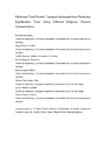Mostrar o rexistro simple do ítem
Peritoneal total protein transport assessed from peritoneal equilibration tests using different dialysate glucose concentrations
| dc.contributor.author | Gomes, Ana Marta | |
| dc.contributor.author | Pérez-Fontán, Miguel | |
| dc.contributor.author | Rodríguez-Carmona, Ana | |
| dc.contributor.author | López-Muñiz, Andrés | |
| dc.contributor.author | Fernández-Villar, Marcos | |
| dc.contributor.author | Peteiro-Cartelle, Javier | |
| dc.contributor.author | García-Falcón, Teresa | |
| dc.date.accessioned | 2023-04-28T07:51:20Z | |
| dc.date.available | 2023-04-28T07:51:20Z | |
| dc.date.issued | 2010-09 | |
| dc.identifier.citation | Gomes AM, Pérez-Fontán M, Rodríguez-Carmona A, López-Muñiz A, Fernández-Villar M, Peteiro-Cartelle J, García-Falcón T. Peritoneal total protein transport assessed from peritoneal equilibration tests using different dialysate glucose concentrations. Perit Dial Int. 2010 Sep-Oct;30(5):549-57. | es_ES |
| dc.identifier.issn | 0896-8608 | |
| dc.identifier.uri | http://hdl.handle.net/2183/32962 | |
| dc.description | Randomized controlled trial | es_ES |
| dc.description.abstract | [Abstract] Background: The peritoneal equilibration test (PET) permits assessment of peritoneal protein transport, but this potential marker of outcome in peritoneal dialysis (PD) patients lacks adequate standardization. ♢ Objectives: To assess various approaches for estimation of peritoneal protein transport in PD patients during 2.27% and 3.86% glucose-based PETs, and to uncover the demographic, clinical, and biochemical correlates of this phenomenon. ♢ Patients and methods: We studied 90 PD patients who underwent 2.27% and 3.86% PETs in random order, and we used multivariate analysis to compare assessments of peritoneal protein transport in both tests, searching for correlations between D₂₄₀' - D₀' protein concentration (PETΔPConc), total peritoneal protein excretion (PET-PPE), or total protein clearance (PET-PC) on the one hand (the main study variables), and PET-derived markers of peritoneal function and selected demographic, clinical, and biochemical variables on the other. ♢ Results: The PETΔPConc was higher during the 2.27% PET (mean: 45.2 mg/dL vs 37.0 mg/dL for the 3.86% test; p = 0.003); the PET-PPE and PET-PC were comparable (1121.8 mg vs 1168.9 mg, p = 0.52, and 17.1 mL vs 17.8 mL, p = 0.66, respectively). All three variables sustained a significant, yet moderate correlation (all r² values < 0.30) with the 24-hour PPE rate. Multivariate analysis identified dialysate-to-plasma ratio (D/P₂₄₀') of creatinine, end-to-initial dialysate ratio (D₂₄₀'/D₀') of glucose, current daily peritoneal glucose load, ultrafiltration during PET, systolic blood pressure, and previous cardiovascular events (3.86% test only) as independent predictors of protein transport during PET. ♢ Conclusions: Either PET-PPE or PET-PC seems preferable to PETΔPConc for characterization of peritoneal protein transport. Small-solute transport characteristics, ultrafiltration, and current peritoneal glucose load sustain independent correlations with peritoneal protein transport. The latter variable shows also a moderate association with markers of cardiovascular disease in PD patients. | es_ES |
| dc.language.iso | eng | es_ES |
| dc.publisher | SAGE | es_ES |
| dc.relation.uri | https://doi.org/10.3747/pdi.2009.00127 | es_ES |
| dc.subject | Peritoneal equilibration test | es_ES |
| dc.subject | Protein transport | es_ES |
| dc.subject | Ultrafiltration | es_ES |
| dc.subject | Cardiovascular disease | es_ES |
| dc.title | Peritoneal total protein transport assessed from peritoneal equilibration tests using different dialysate glucose concentrations | es_ES |
| dc.type | info:eu-repo/semantics/article | es_ES |
| dc.rights.access | info:eu-repo/semantics/openAccess | es_ES |
| UDC.journalTitle | Peritoneal Dialysis International | es_ES |
| UDC.volume | 30 | es_ES |
| UDC.issue | 5 | es_ES |
| UDC.startPage | 549 | es_ES |
| UDC.endPage | 557 | es_ES |






